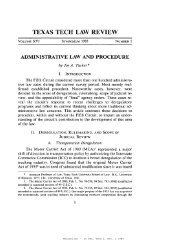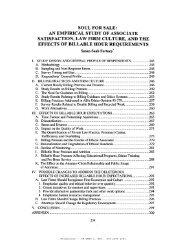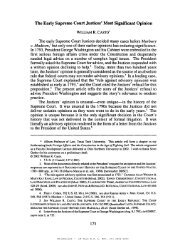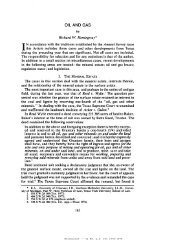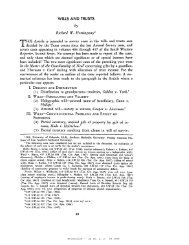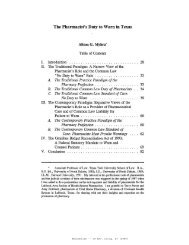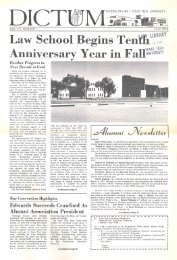NOTES Using the Fair Housing Act to Combat Predatory Lending
NOTES Using the Fair Housing Act to Combat Predatory Lending
NOTES Using the Fair Housing Act to Combat Predatory Lending
Create successful ePaper yourself
Turn your PDF publications into a flip-book with our unique Google optimized e-Paper software.
ueorge<strong>to</strong>wn Journal on t"oveny Law 61: t"OllCY<br />
Volume VI, Number I, Winter 1999<br />
<strong>NOTES</strong><br />
<strong>Using</strong> <strong>the</strong> <strong>Fair</strong> <strong>Housing</strong> <strong>Act</strong> <strong>to</strong> <strong>Combat</strong><br />
Preda<strong>to</strong>ry <strong>Lending</strong><br />
Frank Lopez*<br />
In this article, Frank Lopez examines various solutions <strong>to</strong> <strong>the</strong> widespread<br />
problem ofpreda<strong>to</strong>ry lending. Because minority borrowers are shut out from<br />
mainstream lending institutions, preda<strong>to</strong>ry lenders can make loans with exorbitant<br />
rates and excessive closing costs <strong>to</strong> low-income borrowers. These high<br />
costs often force borrowers in<strong>to</strong> default, allowing lenders <strong>to</strong> foreclose on <strong>the</strong>ir<br />
homes. The Article first discusses <strong>the</strong> evolution and consequences ofpreda<strong>to</strong>ry<br />
lending in poor minority communities. Next, <strong>the</strong> article discusses several<br />
legal options that have been offered as a means <strong>to</strong> combat preda<strong>to</strong>ry lending,<br />
including: <strong>the</strong> Community Reinvestment <strong>Act</strong>, <strong>the</strong> Truth in <strong>Lending</strong> <strong>Act</strong>, <strong>the</strong><br />
Civil Rights <strong>Act</strong> of 1866, and <strong>the</strong> doctrine of unconscionability. The Article<br />
makes a thorough examination of <strong>the</strong>se options, finding that each is inadequate<br />
<strong>to</strong> <strong>the</strong> task ofdeterring preda<strong>to</strong>ry lending practices. Ultimately, Lopez<br />
concludes that <strong>the</strong> <strong>Fair</strong> <strong>Housing</strong> <strong>Act</strong> is <strong>the</strong> most effective means <strong>to</strong> combating<br />
preda<strong>to</strong>ry lending.<br />
CONTENTS<br />
I. INTRODUCTION. . . . . . . . . . . . . . . . . . . . . . . . . . . . . . . . . . . . . . . 74<br />
n. PROBLEM PRESENTED. . . . . . . . . . . . . . . . . . . . . . . . . . . . . . . . . . 75<br />
1lI. CURRENT LEGAL OPTIONS '.' . . . . 80<br />
A. The Community Reinvestment<strong>Act</strong> . . . . . . . . . . . . . . . . . . . . . . 80<br />
B. Truth in <strong>Lending</strong> <strong>Act</strong>. . . . . . . . . . . . . . . . . . . . . . . . . . . . . . . . 83<br />
C. Doctrine ofUnconscionability. " . . . . . . . . . . . .. . . . . . . . . . . 85<br />
D. Civil Rights <strong>Act</strong> of1866: Sections 1981 and 1982 . . . . . . . . . . . 88<br />
IV. FAIR HOUSING ACT: THE MOST VIABLE VEIllCLE FOR CHANGE. . . . 92<br />
A. General Overview. . . . . . . . . . . . . . . . . . . . . . . . . . . . . . . . . . 92<br />
B. Broad Construction of<strong>the</strong> FHA. . . . . . . . . . . . . . . . . . . . . . . . 93<br />
* J.D., George<strong>to</strong>wn University Law Center, 1999; B.S., University of Florida, 1996. I would like <strong>to</strong><br />
thank Peter Edelman, a professor at George<strong>to</strong>wn University Law Center, and John ReIman, an at<strong>to</strong>rney<br />
at <strong>the</strong> Washing<strong>to</strong>n Lawyers' Committee for Civil Rights, for <strong>the</strong>ir insightful contributions. Fur<strong>the</strong>r, on a<br />
personal note, I want <strong>to</strong> thank my wife Jennifer for her daily guidance and my parents for <strong>the</strong>ir<br />
continuing support.<br />
73
als who have been injured by discrimina<strong>to</strong>ry housing practices <strong>to</strong> vindicate <strong>the</strong>ir<br />
own rights. 133<br />
Unfortunately, certain aspects of sections 1981 and 1982 limit <strong>the</strong>ir impact in<br />
<strong>the</strong> fight against reverse redlining. First, because only citizens may sue under<br />
section 1982,!34 non-citizens, many of whom are language minorities,!35 are<br />
precluded from bringing suits regardless of how egregiously a preda<strong>to</strong>ry lender<br />
has taken advantage of <strong>the</strong>m. Sadly, tlns lack of protection has made "language<br />
minorities <strong>the</strong> victims for unscrupulous lenders who prey on <strong>the</strong>ir inability <strong>to</strong><br />
understand <strong>the</strong> tenus of <strong>the</strong> bargain." 136 For example, Hispanic immigrants in<br />
California, unable <strong>to</strong> read English, unknowingly sign documents tlmt convey<br />
full title <strong>to</strong> <strong>the</strong>ir homes <strong>to</strong> loan brokers.!37 Fur<strong>the</strong>r, <strong>the</strong> lender may deter victim<br />
action by using anti-immigrant laws <strong>to</strong> manipulate a borrower's fear of <strong>the</strong><br />
government. For instance, <strong>the</strong> lender may threaten investigation in<strong>to</strong> victims'<br />
immigration status if <strong>the</strong>y complain <strong>to</strong> any government agency or appear in<br />
court <strong>to</strong> contest <strong>the</strong> foreclosure. !38<br />
Additionally, <strong>the</strong> Supreme Court has limited <strong>the</strong> scope of sections 1981 and<br />
1982 <strong>to</strong> discrimination based on "ancestry or ethnic characteristics"-<strong>the</strong><br />
statutes do not directly extend <strong>to</strong> national origin discrimination. l39 Pursuant <strong>to</strong><br />
<strong>the</strong> holdings of <strong>the</strong> Supreme Court, lower courts have dismissed claims asserted<br />
by a Norwegian!40 and a Colombian.!4! Wlnle <strong>the</strong>re will be cases where<br />
national origin overlaps with race (and hence be actionable), it is likely that<br />
<strong>the</strong>re will be plaintiffs who are denied relief under sections 1981 and 1982<br />
because mere birthplace discrimination is insufficient <strong>to</strong> state a claim. !42<br />
It can also be onerous for an organizational plaintiff <strong>to</strong> bring an action under<br />
section 1981 or section 1982, which have been construed as limiting standing <strong>to</strong><br />
"<strong>the</strong> direct victims of <strong>the</strong> alleged discrimina<strong>to</strong>ry practice."!43 Organizational<br />
133. ZUCKERMAN ET AL., supra note 124, at 288.<br />
134. [d. at 8.<br />
135. As used here, a language minority is a person not proficient in <strong>the</strong> English language.<br />
136. Bender, Consumer Protection/or Latinos, supra note 80, at 1030.<br />
137. See Tracy WJ.1k:inson, Elderly, PoorAre Easy Preyfor Home-Equity Schemers, L.A. TIMEs, Oct.<br />
15,1989,atB1.<br />
138. Bender, Consumer Protection for Latinos, supra note 80, at 1035 (citing <strong>to</strong> Memorandum from<br />
Raul Ramirez, Hispanic Outreach Program Direc<strong>to</strong>r, Oregon's At<strong>to</strong>rney General's Office, <strong>to</strong> Timothy<br />
Wood, Financial Fraud Division, OregonAt<strong>to</strong>rney General's Office (May 24, 1995».<br />
139. 81. Francis College v. AI-Khazraji, 481 U.S. 604, 613 (1987) (stating that section 1981 claims<br />
do not necessarily extend <strong>to</strong> nationalities). But see Shaare Tefila Congregation v. Cobb, 481 U.S. 615,<br />
618 (1987) (finding that Arabs and Jews may have standing <strong>to</strong> make section 1982 claims because at <strong>the</strong><br />
time <strong>the</strong> statute was enacted, <strong>the</strong>y were not considered <strong>to</strong> be part of <strong>the</strong> Caucasian race).<br />
140. See Bauge v. Jernigan, 671 E Supp. 709, 712 (D. Colo. 1987) (holding that allegation that<br />
plaintiff was discriminated against because he was Norwegian did not state a section 1983 claim based<br />
on racial animus).<br />
141. See Ana Leon T. v. Federal Reserve Bank, 823 E2d 928, 931 (6th Cir. 1987) (holding<br />
discrimination based on Colombian heritage does not state a claim under section 1981).<br />
142. See St. Francis College, 481 U.S. at 614 (Brennan, J., concurring).<br />
143. <strong>Fair</strong> Employment Council of Greater Wash., Inc. v. BMC Marketing Corp., 28 F.3d 1268, 1279<br />
(D.C. Cir. 1994) (holding that a fair employment organization lacked standing <strong>to</strong> bring a claim under<br />
r I<br />
I II<br />
- -- ------oJ --------0<br />
plaintiffs generally claim standing by arguing that (I) <strong>the</strong>y have been injured in<br />
<strong>the</strong>ir own right as a result of defendant's actions (derivative standing)!44 or (2)<br />
<strong>the</strong>ir members have been directly injured as a result of defendant's actions<br />
. al d') !45<br />
(representation stan mg .<br />
While Article III injury-in-fact is usually quite easy <strong>to</strong> demonstrate---
edlining.!49 Such practices include using solely minority models or concentrating<br />
advertising efforts in low-income, heavily minority communities.!SO This<br />
type of targeted adve!1ising is not actionable under sections 1981 and 1982. 15 !<br />
Therefore, although <strong>the</strong>se practices may be discrimina<strong>to</strong>ry, no legal recourse is<br />
afforded <strong>to</strong> <strong>the</strong> victims under <strong>the</strong> Civil Rights <strong>Act</strong> of 1866.<br />
IV. FAIR HOUSING ACT: THE MOST VIABLE VEffiCLE FOR CHANGE<br />
A. General Overview<br />
Title VIII of <strong>the</strong> Civil Rights <strong>Act</strong> of 1968,!S2 also known as <strong>the</strong> <strong>Fair</strong> <strong>Housing</strong><br />
<strong>Act</strong> ("FHA"), was enacted in response <strong>to</strong> a study that found widespread<br />
residential segregation in America.!S3 The FHA's aim was <strong>to</strong> provide protection<br />
<strong>to</strong> those persons who had suffered housing discrimination on <strong>the</strong> basis of race,<br />
color, religion, or national origin.!54 In 1988, <strong>the</strong> FHA was amended <strong>to</strong> provide<br />
stronger enforcement provisions and expanded coverage.!SS The changes significantly<br />
enhanced <strong>the</strong> legal options for victims of housing-related discrimina<strong>to</strong>ry<br />
practices. Despite <strong>the</strong>se improvements, <strong>the</strong> FHA's potential is still greatly<br />
unrealized. !S6<br />
There are tlrree avenues of action under tl,e FHA. First, a victim can file a<br />
complaint Witll <strong>the</strong> U.S. Department of <strong>Housing</strong> and Urban Development<br />
("HUD").!S7 If, after a thorough investigation, <strong>the</strong> complaint is found <strong>to</strong> be<br />
valid, HUD will attempt <strong>to</strong> resolve <strong>the</strong> problem "tlrrough informal methods of<br />
conference, conciliation, and persuasion.,,!58 Second, <strong>the</strong> At<strong>to</strong>rney General can<br />
choose <strong>to</strong> independently bring a suit in response <strong>to</strong> <strong>the</strong> discrimina<strong>to</strong>ry housing<br />
practice at issue. 159 Cases brought by <strong>the</strong> At<strong>to</strong>rney General can be based on<br />
149. ZUCKERMAN ET AL., supra note 124, at 156.<br />
150. [d.<br />
151. See Spann v. Colonial Village, Inc., 899 F.2d 24, 35 (D.C. Cir. 1990) (holding that sections<br />
1981 and 1982 are not "all-purpose antidiscrimination or comprehensive open housing laws," and that<br />
section 1982 "does not prohibit [real estate] advertising or o<strong>the</strong>r [dwelling place sale or rental]<br />
representations that indicate discrimina<strong>to</strong>ry preferences").<br />
152. 42 U.S.C. §§ 3601-3619, 3631 (1994 & Supp. II 1996).<br />
153. See Robert G. Schwemm, Introduction <strong>to</strong> Mortgage <strong>Lending</strong> Discrimination Law, 28 J.<br />
MARSHALL L. REv. 317 (1995) [hereinafter Schwemm, Mongage <strong>Lending</strong> Discrimination Law] (stating<br />
that, in response <strong>to</strong> urban riots, <strong>the</strong> Kerner Commission Report studied <strong>the</strong> housing disparity between<br />
races in <strong>the</strong> United States).<br />
154. ROBERT G. SCHWEMM, HOUSING DISCRIMINATION LAW 1 (1983).<br />
155. See <strong>Fair</strong> <strong>Housing</strong> Amendments <strong>Act</strong> of 1988, Pub. L. No. 100-430, § 6, .102 Stat. 1619, 1620<br />
(codified as amended at 42 U.S.c. § 3604 (1993)).<br />
156. Schwemm, Mortgage <strong>Lending</strong> Discrimination Law, supra note 153, at 332.<br />
157. Jane McGrew et al., Washing<strong>to</strong>n Lawyers' Committee for Civil Rights Under <strong>the</strong> Law: <strong>Fair</strong><br />
<strong>Housing</strong>, 27 How. L.J. 1291, 1319 (1984).<br />
158. [d.<br />
159. [d.<br />
r I<br />
l"tU . .lJ r 1CUi:1lUlY LCUWUg ';Ij<br />
ei<strong>the</strong>r a "pattern or practice" of denying Title VIII rights or an "issue of general<br />
public importance." !60 Finally, <strong>the</strong> complainant can bring a private suit against<br />
<strong>the</strong> offender. !6!<br />
To sustain an action under <strong>the</strong> FHA, <strong>the</strong> plaintiff must prove four elements.!62<br />
First, <strong>the</strong> plaintiff's discrimination must be attributable <strong>to</strong> one of <strong>the</strong> protected<br />
categories: race, COlOT, religion, sex, national origin, familial status, or disability.<br />
]63 Second, <strong>the</strong> discrimination must occur in <strong>the</strong> context of <strong>the</strong> sale or rental<br />
of a dwelling.!64 Third, <strong>the</strong> specific type of transaction at issue must be<br />
covered. !6S Finally, <strong>the</strong> plaintiff must meet <strong>the</strong> required standard ofproof.!66<br />
B. Broad Construction of<strong>the</strong> FHA<br />
In Trafficante v. Metropolitan Life Insurance .co., <strong>the</strong> Supreme Court held<br />
that claims brought under <strong>the</strong> FHA will be broadly construed.! 67 A later decision<br />
by <strong>the</strong> U.S. Court of Appeals for <strong>the</strong> Sixth Circuit expanded on <strong>the</strong> holding in<br />
Trafficante by reasoning that <strong>the</strong> legislative intent of <strong>the</strong> FHA was <strong>to</strong> "eliminate<br />
all traces of discrimination within <strong>the</strong> housing field.,,!68 Under <strong>the</strong> FHA, one<br />
may not "engag[e] in residential or real estate-related transactions <strong>to</strong> discriminate<br />
against any person in making available such a transaction, or in <strong>the</strong> terms<br />
or conditions of such a transaction, because of race, color, ... or national<br />
origin."!69 The phrase "terms or conditions" includes mortgages and foreclosure<br />
terms.!70 Consequently, reverse redlining cases involving institutions charging<br />
egregious interest rates <strong>to</strong> minorities should fall within <strong>the</strong> scope of <strong>the</strong><br />
FHA.<br />
160. ZUCKERMAN ET AL., supra note 124, at 203 (quoting 42 U.S.c. § 3614(a) (1994)).<br />
161. The plaintiff must commence <strong>the</strong> action within two years of <strong>the</strong> last occurrence of <strong>the</strong><br />
"discrimina<strong>to</strong>ry housing practice." [d. Prior <strong>to</strong> <strong>the</strong> 1988 amendments, <strong>the</strong> statute oflimitations afforded<br />
<strong>to</strong> <strong>the</strong> plaintiff was merely 180 days. ld. See infra Part IV.C.iv (describing <strong>the</strong> continuing violations<br />
doctrine's applicability <strong>to</strong> <strong>the</strong> statute oflimitations).<br />
162. Schwemm, MOJ1gage <strong>Lending</strong> DiscriminationLaw, supra note 153, at 325.<br />
163. [d.<br />
164. [d. See also 42 U.S.c. § 3602(b) (defining "dwelling").<br />
165. Schwemm, Mortgage <strong>Lending</strong> Discrimination Law, supra note 153, at325-26. The language of<br />
<strong>the</strong> FHA explicitly covers financial discrimination. leI. at 326.<br />
166. Id. at 326. See infra Part N.C.ii (discussing <strong>the</strong> required standard ofproof under <strong>the</strong> FHA).<br />
167. 409 U.S. 205, 208 (1972) (stating that <strong>the</strong> language of<strong>the</strong> FHA is broad and inclusive).<br />
168. Marr v. Rife, 503 F.2d 735,740 (6th Cir. 1974).<br />
169. 42 U.S.c. § 3605(a) (1994)) (emphasis added).<br />
170. See, e.g., Harper v. Union Sav. Ass'n, 429 F. Supp. 1254, 1257 (N.D. Ohio 1977) ("This court<br />
concludes that it is <strong>the</strong> intent of Congress that section 3605's prohibitions against discrimination on <strong>the</strong><br />
part of lending institutions in connection with real estate loans proscribe discrimination in <strong>the</strong> manner<br />
in which a lending institution forecloses a delinquent or defaulted mortgage note since <strong>the</strong> right of<br />
foreclosure is one of <strong>the</strong> 'teans or conditions of such loan.' "); 42 U.S.C. § 3605(b)(1) (1994) (defining<br />
"residential real estatehrelated transactions" as "<strong>the</strong> making ... of loans or providing o<strong>the</strong>r financial<br />
assistance-for purchasing, constructing, improving, repairing, or maintaining a dwelling; or [making<br />
or purchasing of loans] secured by residential real estate")..
3. Potential Remedies<br />
The 1988 amendments <strong>to</strong> <strong>the</strong> FHA have "had a substantial effect on <strong>the</strong><br />
availability of remedies.,,236 A plaintiff may now seek equitable remedies such<br />
as injunctions or restraining orders,23? compensa<strong>to</strong>ry and punitive damages,Z38<br />
and at<strong>to</strong>rneys' fees and costS.Z 39 The Supreme Court has conferred broad<br />
discretion <strong>to</strong> lower courts in "fashioning an effective eqnitable remedy."24o<br />
Injunctive relief should be structured <strong>to</strong> "achieve <strong>the</strong> twin goals of assuring that<br />
<strong>the</strong> [FHA] is not violated in <strong>the</strong> future and removing any lingering effects of<br />
past discrimination."241 Under a preda<strong>to</strong>ry lending claim, <strong>the</strong> court may order a<br />
consent decree requiring <strong>the</strong> defendant's employees <strong>to</strong> sign a non(1iscrimination<br />
statement, mandating record-keeping <strong>to</strong> enable judicial moni<strong>to</strong>ring, and requiring<br />
fair housing law training for employees. 242<br />
Although equitable relief may deter a preda<strong>to</strong>ry lender fTom future discrimina<strong>to</strong>ry<br />
practices, victims may not have <strong>the</strong> incentive <strong>to</strong> bring a claim if <strong>the</strong>y are<br />
not reimbursed for <strong>the</strong> hann suffered. Compensa<strong>to</strong>ry damages serve <strong>the</strong> function<br />
of "putting <strong>the</strong> [victim] in <strong>the</strong> same position he would have been in had<br />
<strong>the</strong>re been no injury,,,z43 and providing incentives for <strong>the</strong> victim <strong>to</strong> file a claim.<br />
A plaintiff is entitled <strong>to</strong> recover damages for out-of-pocket expenses, humiliation,<br />
embarrassment, mental anguish, emotional distress, and loss of civil rights<br />
incurred as a result of <strong>the</strong> defendant's actions 244<br />
The most potent weapon in deterring preda<strong>to</strong>ry lending is likely tl,e threat of<br />
punitive damages. Originally, punitive damages under <strong>the</strong> FHA were capped at<br />
$1,000?45 However, <strong>the</strong> 1988 amendments eliminated this limitation 246 and in<br />
recent years, punitive damage awards have escalated. 24 ? Like any o<strong>the</strong>r business,<br />
preda<strong>to</strong>ry lenders are motivated by profitability. Unfortunately, foreseeable<br />
borrowing needs, and will likely not turn <strong>to</strong> preda<strong>to</strong>ry lenders who charge exorbitant interest rates and<br />
fees. As such, by failing <strong>to</strong> offer prevailing market terms <strong>to</strong> whites, <strong>the</strong> preda<strong>to</strong>ry lender, its branchoffices,<br />
and its parent and subsidiary corporations, would have <strong>to</strong> forego serving whites, who make up<br />
<strong>the</strong> vast majority of <strong>the</strong> population, and are a significant market.<br />
236. ZUCKERMAN ET AL., supra note 124, at 270.<br />
237. 42 U.S.c. § 3613(c)(I) (1994).<br />
23S. Id.<br />
239. Id. § 3613(c)(2).<br />
240. Jones v. Alfred Mayer Co., 392 U.S. 409, 414 n.13 (196S).<br />
241. Marable v. Walker, 704 F.2d 1219, 1221 (11th Cir. 1983); see also United States v. James<strong>to</strong>wn<br />
Center-in-<strong>the</strong>-Grove Apartments, 557 F.2d 1079, 1081 (5th Cir. 1977) ("Relief for violations of <strong>Fair</strong><br />
<strong>Housing</strong> <strong>Act</strong> should be aimed <strong>to</strong>ward insuring that no future violations of <strong>the</strong> <strong>Act</strong> occur and removing<br />
any lingering effects of past discrimination.").<br />
242. ZUCKERMAN ET AL., supra note 124, at 284.<br />
243. Id. at 277 (quoting Lee v. Sou<strong>the</strong>m Home Sites COJp., 419 F.2d 290, 293 (5th Cir. 1970».<br />
244. RELMAN, supra note 176, at 6-1.<br />
245. Di Lorenzo, supra note 56, at 1763 (discussing <strong>the</strong> reasons that enforcement of <strong>the</strong> FHA was<br />
weak prior <strong>to</strong> <strong>the</strong> 1988 amendments).<br />
246. See 42 U.S.C. § 3613(c)(I) (1994) (permitting <strong>the</strong> comt <strong>to</strong> award actual and punitive damages<br />
for a finding of discrimina<strong>to</strong>ry housing practice).<br />
247. RELMAN, supra note 176, at 6-23.<br />
compensa<strong>to</strong>ry damages may merely be viewed by defendants as operating costs.<br />
Consequently, <strong>the</strong> best way <strong>to</strong> instigate reform of discrintina<strong>to</strong>ry lending practices<br />
is <strong>to</strong> elintinate <strong>the</strong> potential for profitability by hitting <strong>the</strong> defendants<br />
where it really hurts: in <strong>the</strong> wallet?48 Courts will do a case-by-case inquiry in<strong>to</strong><br />
<strong>the</strong> defendant's culpability when determining <strong>the</strong> amount of punitive damages<br />
that will sufficiently punish <strong>the</strong> defendant and deter <strong>the</strong> defendant from future<br />
wrongdoing 249<br />
The FHA also entitles <strong>the</strong> plaintiff in a preda<strong>to</strong>ry lending claim <strong>to</strong> reasonable<br />
at<strong>to</strong>rneys' fees and costs if she prevails. 250 A plaintiff will be considered <strong>the</strong><br />
"prevailing" party if she succeeds on any significant issue in <strong>the</strong> case 251 Unlike<br />
section 1982, which allows <strong>the</strong> defendant <strong>to</strong> recover at<strong>to</strong>rneys' fees, only <strong>the</strong><br />
plaintiff may qualify <strong>to</strong> recover at<strong>to</strong>rneys' fees under <strong>the</strong> FHA 252 Although a<br />
losing plaintiff will rarely be assessed <strong>the</strong> defendant's at<strong>to</strong>rney's fees under<br />
section 1982, eliminating this possibility in FHA claims may invite victims of<br />
preda<strong>to</strong>ry lending <strong>to</strong> file suit who would o<strong>the</strong>rwise be discouraged from doing<br />
so.<br />
253<br />
4. Continuing Violations Docrrine<br />
The statute of limitations has a great impact on <strong>the</strong> number of suits filed<br />
against a preda<strong>to</strong>ry lender. The shorter <strong>the</strong> limitation period, <strong>the</strong> greater <strong>the</strong> risk<br />
that potential plaintiffs will be disqualified. Pursuant <strong>to</strong> <strong>the</strong> 1988 amendments,<br />
<strong>the</strong> statute of limitations under <strong>the</strong> FHA was extended from 180 days <strong>to</strong> two<br />
years?54 However, <strong>the</strong> court must determine <strong>the</strong> point upon which <strong>the</strong> statute<br />
begins <strong>to</strong> <strong>to</strong>ll before it can consider whe<strong>the</strong>r or not <strong>the</strong> claim is barred.<br />
In Havens Realty Corp. v. Coleman, <strong>the</strong> Supreme Court found that when a<br />
plaintiff challenges an unlawful practice under <strong>the</strong> FHA, continning violations<br />
of <strong>the</strong> practice are afforded a more liberal analysis than isolated acts of<br />
discrimination?SS Under <strong>the</strong> FHA, <strong>the</strong> statute of limitations commences after<br />
<strong>the</strong> alleged discrimina<strong>to</strong>ry housing practice occurred. 256 The defendant in Ha-<br />
248. "II]t is quite clear that <strong>the</strong> central purpose of <strong>the</strong> [<strong>Fair</strong> <strong>Housing</strong> <strong>Act</strong>] is <strong>to</strong> accelerate <strong>the</strong><br />
eradication of housing disclimination acrOSS <strong>the</strong> country by making such conduct prohibitively expensive."<br />
Id. at 6-26.4.<br />
249. Courts differ as <strong>to</strong> <strong>the</strong> requisite culpability for punitive damages. Some courts require knowledge<br />
of <strong>the</strong> discrimina<strong>to</strong>ry practice while o<strong>the</strong>rs find that willful or reckless disregard of <strong>the</strong> plaintiff's'<br />
rights will walTant pecuniary punishment of <strong>the</strong> defendant. Id. at 6-20.<br />
250. 42 U.S.C. § 3613(c)(2) (1994).<br />
251. RELMAN, supra nole 176, at 6-31 (citing Hensley v. Eckerhart, 461 U.S. 424, 433 (1983».<br />
252. The courts have read a "double standard" in<strong>to</strong> section 1982 under which <strong>the</strong>re is no differentiation<br />
between a prevaili.ng defendant and plaintiff. Schwemm, Mortgage <strong>Lending</strong> Discrimination Law,<br />
supra note 153, at 329 (citi.ng Roadway Express, Inc. y. Piper, 447 U.S. 752, 762 (1980».<br />
253. Id. a1330.<br />
254. 42 U.S.C. § 3613(a)(l)(A) (1994). A private complaint <strong>to</strong> HUD has a statute of limitations of<br />
one year. 42 U.S.C. § 361O(a)(I)(A)(i) (1994).<br />
255. 455 U.S. 363, 3S1 (1982).<br />
256. 42 U.S.C. § 3610(a)(I)(A)(i) (1994). See also Thelma A. Civens, The Cantinuing Walatian<br />
Theory and Systematic Discrimination: In Search ofa Judicial Standardfor Timely Filing, 41 VAND. L.
yens argued that each discrete act of housing discrimination constituted an<br />
"occurrence. ,,257 However, <strong>the</strong> Supreme Court held that in order <strong>to</strong> meet <strong>the</strong><br />
broad remedial intent of <strong>the</strong> FHA in eliminating systematic discrimination, a<br />
claim for continuing violations commences at <strong>the</strong> time of <strong>the</strong> last occurrence of<br />
<strong>the</strong> discrimina<strong>to</strong>ry practice. 258 The court reasoned that "[w]here <strong>the</strong> challenged<br />
violation is a continuing one, <strong>the</strong> staleness concern disappears.,,259 Consequently,<br />
a plaintiff under a reverse redlining claim will not necessarily be<br />
precluded from filing suit even if it has been over two years since she was<br />
personally discriminated against. Instead, <strong>the</strong> court will focus on whe<strong>the</strong>r <strong>the</strong><br />
preda<strong>to</strong>ry lending practice by <strong>the</strong> defendant, irrespective of <strong>the</strong> plaintiff, has<br />
occurred within <strong>the</strong> past two years. For example, if victim X was targeted by<br />
Preda<strong>to</strong>ry Lender Mortgage Co. four years ago, but victim Z was targeted only<br />
one year ago, <strong>the</strong>n victim X will still have a viable claim under <strong>the</strong> continuing<br />
violations doctrine.<br />
V. CONCLUSION<br />
Over <strong>the</strong> past four decades, significant strides have been made in overcoming<br />
blanket refusals of lending institutions <strong>to</strong> extend mortgage loans in minority<br />
communities. Today, discrimina<strong>to</strong>ry lending practices, although egregious, are<br />
not as apparent. Preda<strong>to</strong>ry lenders conceal reverse redlining practices under <strong>the</strong><br />
guise of opportunities <strong>to</strong> minorities who would not o<strong>the</strong>rwise be able <strong>to</strong> obtain<br />
financing. In reality, preda<strong>to</strong>ry lending has resulted in financial and psychological<br />
distress for its victims.<br />
While numerous legal options might be used <strong>to</strong> address this problem, none<br />
has been able <strong>to</strong> provide a consistently viable remedy. Some, such as tl,e CRA<br />
and TILA, have <strong>the</strong> potential <strong>to</strong> uncover and rectify some preda<strong>to</strong>ry lending<br />
practices, but <strong>the</strong>y lack sufficient bite <strong>to</strong> be tmly useful as deterrents. The CRA<br />
provides a significant cause of action, but does not provide adequate standing<br />
for certain groups, such as language minorities, testers, and housing organizations.<br />
Similarly, sections 1981 and 1982 of <strong>the</strong> Civil Rights <strong>Act</strong> of 1866 have<br />
relatively strict standing requirements .and do not allow for disparate impact<br />
claims. Finally, <strong>the</strong> doctrine of unconscionability, while seemingly invented for<br />
such cases, is <strong>to</strong>o ambiguous <strong>to</strong> rely on in preda<strong>to</strong>ry lending cases.<br />
In contrast <strong>to</strong> <strong>the</strong> options described above, <strong>the</strong> FHA has great potential in<br />
REv. 1171, 1183-84 (1988). It should be noted that Havens was decided prior <strong>to</strong> <strong>the</strong> 1988 amendments,<br />
thus <strong>the</strong> statute of limitations period was 180 days under section 3612(a). See id. at 1182.<br />
257. Coles v. Havens Realty Corp., 633 F.2d 384, 385 (4tll CiT. 1980), modified, 455 U.S. 363<br />
(1982).<br />
258. Havens Realty Corp. v. Coleman, 455 U.S. 363, 380-81 (1982).<br />
259. Havens, 455 U.S. at 380.<br />
reverse redlining cases. The FHA has broad standing requirements; multiple<br />
causes of action, including disparate impact claims; strong remedial potential;<br />
and <strong>the</strong> continuing violations doctrine. Because of <strong>the</strong>se, <strong>the</strong> FHA stands out as<br />
<strong>the</strong> most viable means <strong>to</strong> remedy <strong>the</strong> scourge of preda<strong>to</strong>ry lending.



